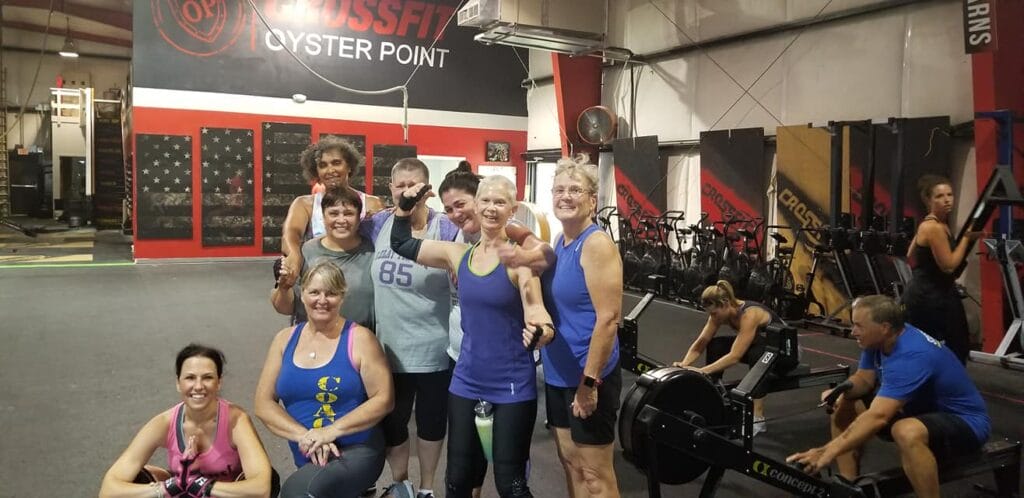Many of you may have seen the recent article “Exercises To Modify Over 50” in Reader’s Digest published last week. When the coaches at OP first got wind of this, the article was originally named “Exercises to Avoid if Over 50”. Much like the coaches, I am sure many of our regular gym-goers shared our shock at the originally titled article.
We all know that humans have been proving, even before the inception of CrossFit, that age is just a number and certainly not a limiting factor when it comes to exercise and weight training. Being the daughter of a father who was a former bodybuilder turned ultra-marathoner turned cyclist, and a mother who continues her almost 40 years of running and weightlifting, I find it hard to believe articles that caution older age groups about weight lifting and exercise. And, let’s not forget our athletes at OP:


Our Legends class members, masters athletes, and world record setting coaches are a testament to strength and ability in older age.
Read about Coach Roxy here
So, why is it important to continue weight lifting and exercise throughout our life, even in older age groups?

Research has shown that our muscle mass decreases 3-5% each decade past the age of 50 (Human Kinetics, 2018). Therefore, it is incredibly important that humans continue strength training and exercise well past the age of 50. Things like picking up groceries, climbing stairs, doing yard work or household chores, and playing with our grandchildren will be easier while maintaining a strength training regimen. In CrossFit, we learn body movement better – squatting translates to standing up and sitting down each day, box step ups translate to climbing stairs, farmer carries translate to carrying groceries – the list goes on (are you catching on to why we call them functional movements J?).
Additionally, through regular exercise, we are combatting many common silent killers resulting from sedentary lifestyles and poor diet such as obesity, diabetes, high blood pressure, high cholesterol, heart disease, stroke, arthritis, osteoporosis, low back pain, and numerous types of cancer (Human Kinetics, 2018). Health care to treat these chronic diseases cost the United States $117 billion a year – that. is. nuts (CDC, 2016)! So, rather than avoiding or modifying strength training “due to age”, let’s avoid chronic diseases.
Now I will dissect some statements from the Reader’s Digest article and translate them to a more supportive stance for exercise past the age of 50:
“…but it can cause excessive strain if you’re not already in great shape.”
Every coach cringes at this statement. This statement alone can turn a lot of people away from weight training and exercise because they are under the assumption they must “already be in shape” to join. We disprove this theory at CrossFit every day, and understand that while not everyone is at the same level, everyone can start somewhere.
“[Pushups] put a lot of pressure on the shoulders, a complex network of muscles, joints, and ligaments that have often suffered strains and injuries by mid-life.”

“Bench pressing creates a lot of tension and stress on your neck and shoulders”
You know what else causes a lot of tension and stress on your neck and shoulders? Sitting at a desk all day. You want to know how to train your body to feel less stress in your neck and shoulders? CrossFit teaches us how to build our core and maintain proper posture, and also identify movements to help combat the effects of sitting.
“Spin classes can cause too much strain on the joints; a better option would be to spin on your own at your pace, or bike outdoors on a trail,”
Your kids and grandkids will likely not want to go “at your own pace”. In CrossFit, we learn to how to build our endurance and stamina in order to keep up with little ones.
Now, don’t get me wrong – there is some truth to the fact that some exercises should be modified for certain individuals, but the root cause of modifying movements is most certainly not because of age. Many modifications for exercise stem from poor mobility or flexibility, lack of knowledge on proper strength training and exercise, and past injuries or surgeries. Additionally, many “modified movements” are a stepping-stone to full execution of a movement – and we provide you the knowledge, safety, and tools to eventually get you there!
So remember – CrossFit makes you better at life…at any age.
References
Human Kinetics (2018). 13 Benefits of Strength Training for People Older Than 50. Retrieved from http://www.humankinetics.com/news-and-excerpts/news-and-excerpts/13-benefits-of-strength-training-for-people-older-than-50.
Center for Disease Control and Prevention (2016). Nutrition, Physical Activity, and Obesity. Retrieved from https://www.cdc.gov/chronicdisease/resources/publications/aag/dnpao.htm.








